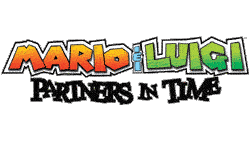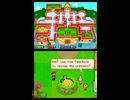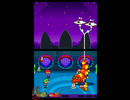|
|

|
BATTLE SYSTEM
|

|
INTERACTION
|

|
ORIGINALITY
|

|
STORY
|

|
MUSIC & SOUND
|

|
VISUALS
|

|
CHALLENGE
|
Above Average
|
COMPLETION TIME
|
20-25 Hours
|
|
OVERALL
4.0/5
|
Rating definitions
|
|
|
When a young and odious reptile breaks into the Mushroom Kingdom's Castle in an attempt to kidnap the wailing baby princess, it seems like all hope is lost... until a surprisingly buff toddler garbed all in red shows up to whomp the fire-breathing assailant. Meanwhile, in the present day, the brilliant Professor E. Gadd is testing his latest invention: a time machine. Princess Peach is amazed, and requests a trip to the past to see the Mushroom Kingdom of old. Of course, these things never go quite smoothly, so in the midst of her jaunt into the past, Peach is -- you guessed it -- kidnapped. Not by Bowser, however, but by a mysterious race of alien invaders who quickly conquer the past's Mushroom Kingdom. It's up to the Brothers Mario, who soon team up with the infant versions of themselves, to save the day... or days, in this case.
Mario & Luigi: Partners in Time is at times zany and farcical, playing up slapstick insanity and a reliance on pantomime communication from the mostly mute brothers. Other times, the lighthearted game is possessed of a deadpan wit that, with a wink and a nod, often breaks down the fourth wall. The game is at no time, however, remotely serious. Whenever a dramatic moment arrives which could serve to interrupt the comedic flow, Mario & Luigi quickly reasserts its nature by injecting some trademark levity.
This is not a game about political or religious clashes, or an emotional struggle to save the world or a hero's loved ones. The game's story is all about getting laughs from the player, and at this, it succeeds riotously. The villains are weirdly surreal, and constant companion Stuffwell engages in quirky malapropisms. The series' frequent objects of mockery and scorn, such as Luigi, Bowser, Baby Bowser, and Toadsworth, all get their lumps in due order. What's more, quite a few truly hilarious situations are set up, such as memorable scenes involving the Hammer Bros. and the Star Gate, and one scene parodically lifted straight from Godzilla. It's undeniably charming and funny, and the beaten-down heroes, whether they're constantly struggling to convey their message without benefit of words or fighting to keep the babies from wandering off into certain death, consistently amuse. It is to the game's benefit that it is blessed with a truly outstanding translation and great writing.
Despite the hilarious nature of the story, the true joy of Mario & Luigi comes in its battles. The game's combat takes the bulk of its mechanics from its predecessor, Mario & Luigi: Superstar Saga. Attacks are performed by pulling off timed button presses, and the success of the attack depends on pressing the buttons accurately. Once again, Mario is controlled with the A button while his leaner and meaner brother is manipulated with the B button. This time around, though, things get a little bit more involved with the babies inserted into the mix. The elder brothers carry their younger selves piggyback. While Mario is attacking, the X button can be pressed at the right time for Baby Mario to pull off an assistance combo; the same goes for Luigi and Baby Luigi, only with the Y button instead. It's a fun, fast-paced battle system that keeps the player heavily involved in events. While some could fault the game for retaining the core mechanics from Superstar Saga, there's no need -- it's a solid system, and one of the very best in turn-based RPGing.
 Let's Do the Time Warp Again
Let's Do the Time Warp Again
|
|
Further, the game still implements enough new features to keep things interesting. While the first game integrated super moves through consumable Bros. Points and learned special abilities, Partners in Time ditches the ability-based approach and handles things instead with usable items that require teamwork, sometimes by all four members of the battle party. These Bros. Items include such Mario world staples as red and green shells, fire flowers, and chomps, tallying out to over twenty different special moves in all. There's a slight downside in that the player doesn't get the rewarding feeling of learning new moves, but this con is easily mitigated by everything that Bros. Items do right. There's a wide variety of them, giving players a far larger arsenal than was ever available in Superstar Saga and opening up lots of options for the player -- certain items work best in different situations, giving a strategic edge to the player who learns each enemy's weakpoints and how the different Bros. Items function. There's also a lot of room for personal taste: some players will have more fun using the trampoline, while others prefer mix flowers, and the game allows for these differences of opinion.
Because of how generally cheap and readily available the Bros. Items are, they constitute a big part of combat, and in the later stages of the game, using them is often a necessity. It's through these items that the combat system really begins to shine, as they take the simple idea of timed button presses and inject a good dose of steroids. Using more difficult Bros. Items will require rapid thinking, far more than just rapid reflexes, and they contribute a downright hectic fervor to the battles that really set them apart from the standard. In the crazily chaotic nature of this combat system, the best challenge can come to the player who tries to keep item combos going as long as possible, and it just makes the game a blast to play.
The combat system is at its best when the brothers are going head to head with the many unique bosses. Partners in Time offers up some of the most original bosses seen in ages; not only are they original in style, but each boss incorporates elements of puzzle-solving as a step to beating them. It's unusual, but it works excellently. Some of the later bosses can seem to drag on, as they have high hit points, but proper use of Bros. Items, rather than standard attacks, is the key to victory.
Another spot where Partners in Time truly excels is in presenting some fantastic level design. While there was truly an impressive degree of explorability in Superstar Saga, the overworld and nearly all of the dungeons were bland and uninspiring. About every area in the game picked from approximately five repetitive backgrounds. The sequel, while sacrificing an explorable overworld in favor of a hub design using Peach's Castle as home base, rectifies the poor level design. Dungeons are varied, colorful, and full of lively and detailed backgrounds. Whether it's Thwomp Volcano or the jungles of Yoshi Island, each area carries with it a distinctive flavor and challenge. Nevertheless, the hub style is disappointing in how linear it serves to make the game; ideally, the game would have meshed its fantastic level design with an explorable overworld littered with optional side quests. The game could also have benefited from a few more towns to help showcase its excellent dialog.
 He Looks Pissed
He Looks Pissed
|
|
The graphics are excellent, and prove why 2D sprite-based RPGs still haven't gone out of style years after the advent of 3D and cinematic storytelling. The game's sprites are marvelously and fluidly animated, the art direction is spot on, and the backgrounds just come alive with all their vibrant colors and detail. The music in the game is nice, if not exceptional. Yoko Shimomura, who also scored Superstar Saga as well as the original Super Mario RPG, returns for duty, and while her compositions don't break much new ground, they're fun to listen to. Her standout tracks are, as usual, the battle anthems. Overall, it's forgettable but entertaining fare -- in this series, Shimomura still hasn't managed to top her work in the original game.
In the end, Mario & Luigi: Partners in Time provides a wonderfully entertaining experience with truly refined gameplay on every level. While some can criticize the game for not deviating enough from its predecessor, Partners introduces enough new content that it hardly feels like a rehash, and most of what works in the first game is new and improved in the sequel. The game's biggest flaw is in its linearity and lack of side quests, but this isn't a fatal flaw, as the content the game does have is golden. Overall, Partners in Time is about even with its predecessor, if not just a little bit better. The game is highly recommended for any DS owner looking for a great RPG.
Review Archives
|









